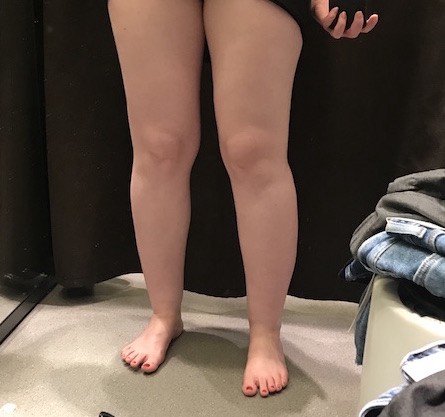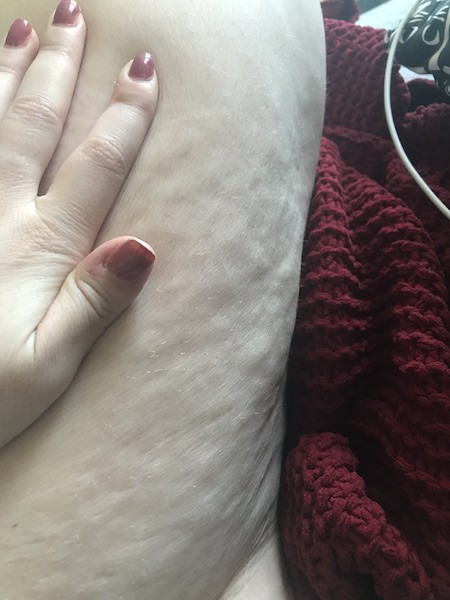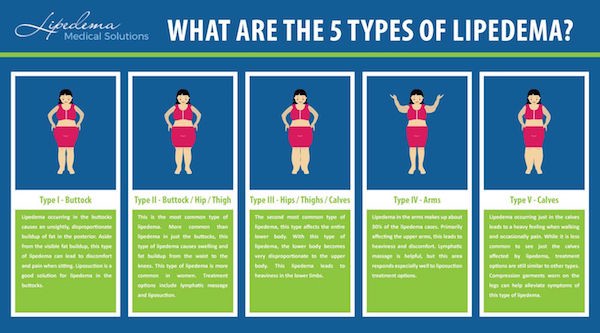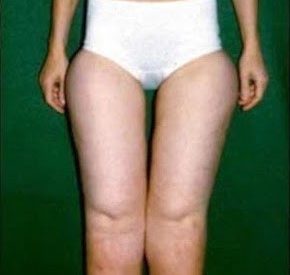After spending over 15 years trying to understand why I couldn?t lose weight on my legs with diet and exercise, a medical diagnosis revealed the cause
 This is me. I look skinny, right? 🙂
This is me. I look skinny, right? 🙂
I think I was about 14 when I started comparing my body to those of other women. At 5’7″ and 127 lbs, my body looked like that of most skinny girls, but only from the waist up. My legs, however, looked like they belonged to someone else ? someone twice my weight.
For years, I made an effort not to care, while trying a little bit of everything to lose weight. I visited countless doctors, who could only tell me to exercise more, and one of them even misdiagnosed me with varicose veins(!). At one point I was spending 2 hours a day at the gym and eating only 200 calories. At my lowest, I weighed 108 lbs, but my body didn?t change a lot, other than the bones being more apparent on my arms and shoulders. My legs were the same.
As I got older, I gained a little bit of weight. Today, at 29, I weigh about 145 lbs. My BMI is 22.5 ? still within the normal range. For me to be considered overweight, I?d have to gain at least 15 lbs. And to be obese, I?d need to put on at least 46 lbs. However? these are my legs:
 This is also me, trying on pants. It?s a challenge to find one that fits. If I want skinny jeans, I need to buy straight jeans, because otherwise, they won?t fit on my ?cankles?
This is also me, trying on pants. It?s a challenge to find one that fits. If I want skinny jeans, I need to buy straight jeans, because otherwise, they won?t fit on my ?cankles?
As someone who?s spent my whole life hiding my legs (not even wearing skirts or dresses), trust me, it?s hard to post this on the internet. But I don?t want other people to go through what I?ve been through, blaming themselves for years and looking for solutions that won?t change anything.
About a month ago, I was diagnosed with a disease called lipedema (or lipoedema), also known as ?painful fat syndrome.? The pain was, actually, the symptom that made me look for help. For at least 6 months, I?ve had pain in different places on my legs (ankles, shins, knees, thighs). And nothing makes the pain go away (I?ve tried anti-inflammatory meds, ice, KT tape, Epsom salts, CBD gel, and so on).
Lipedema was first described in 1940, by the Mayo Clinic ? a leader in medical research. It?s a disease in which the fat cells grow in an abnormal way. With time, these cells start blocking the veins and the lymphatic system, which prevents drainage, causing fluid to build up, and in later stages, lymphedema. The cells also begin to press on the nerves, which is thought to be the reason for most of the lipedema pain.
Despite that, the disease is not very well known even by the medical community. Partly, because there?s no cure. Yes, because even though lipedema is a fat disorder, it?s a different kind of fat, and does not respond to exercise or diet. There is a picture, a bit graphic, that shows the difference between normal fat and lipedema fat. If you want to see it, click here. The abnormal fat is also visible when you squeeze the skin:
 Lipedema fat nodules seen under the skin
Lipedema fat nodules seen under the skin
That?s why the only way to remove the fat is surgically, through liposuction ? which should only be performed by surgeons with lipedema experience, since you have to be gentle with the veins and the lymphatic system, which are already compromised by the disease. This website has a list of all the doctors around the world that treat lipedema. Most of them are in Europe, where the disease seems to be more common and more researched, however, there are quite a few specialists in the United States as well.
Surgery, however, does not cure the disease, and there has been a small percentage of cases where the fat grew back (especially if all the diseased fat cells are not removed). It?s also important to treat the symptoms (pain, venous insufficiency, water retention) for life with MLD (manual lymphatic drainage), compression garments, and light exercise?high-impact exercises, like running, are not recommended, because they aggravate the disease.
It?s known that lipedema occurs mostly on women, and there?s a genetic component ? usually, mothers and grandmothers have it too. In my case, I inherited it from my paternal grandmother. Men rarely develop the disease.
 This was my grandma; you can tell by the picture that she had lipo-lymphedema, an advanced stage of the disease
This was my grandma; you can tell by the picture that she had lipo-lymphedema, an advanced stage of the disease
It?s also known that the disease tends to develop or worsen during moments of hormonal change, such as puberty, pregnancy, and menopause. It is, however, commonly confused with obesity, since most people affected are also obese ? obesity seems to be a factor that contributes to the disease. Usually, it starts on the legs, and it can spread to other areas, especially arms.
There are 4 stages of the disease, and 5 types:
 The four stages of lipedema. Usually, the disease starts on stage 1 and progresses with time
The four stages of lipedema. Usually, the disease starts on stage 1 and progresses with time The five types of lipedema: Type 1 (buttocks); Type 2 (buttocks, hips, and thighs); Type 3 (hips, thighs, and calves); Type 4 (arms); Type 5 (calves)
The five types of lipedema: Type 1 (buttocks); Type 2 (buttocks, hips, and thighs); Type 3 (hips, thighs, and calves); Type 4 (arms); Type 5 (calves)
The symptoms
These are some of the main symptoms of lipedema:
- Legs with a ?column-like? aspect, disproportional to the rest of the body; usually, the areas most affected are knees and ankles, which have a distinctive ?cuff? of fat (feet are usually unaffected, unlike lymphedema). Cankles are also common.
- Pain and heavy feeling on legs
- Legs that bruise easily
- Family history
- Hyper-sensibility to the touch
- Skin that has low elasticity, often times very fair and transparent
- Cold skin, especially on legs
- Hyper-mobility (some also have EDS, Ehlers-Danlos syndrome)
- Fatigue
- Vitamin and mineral deficiencies, such as vitamin D, B12, iron, magnesium, etc.
- Thyroid issues are also common, such as hypothyroidism
The treatments
Lipedema has no cure, however, there are some treatments that help:
- Liposuction (the only way to remove the fat)
- MLD, dry brushing, gua-sha, vibration, trampolines, and anything that helps move fluid and blood
- Light exercise, like walking, cycling, pilates, and especially aquatic exercises (swimming, etc.) are most recommended because the water pressure acts as natural compression on the skin. High-impact exercises, such as running, are not recommended, because they aggravate the disease
- Some people claim to have lost weight and managed the disease with paleo/AIP and keto diets
- There are also recommended supplements that help with symptoms. Dr. Karen Herbst, one of the main specialists on the subject, has a great list
 One of the most famous pictures of lipedema, on an anorexic woman; unlike normal fat, the disease does not respond to caloric restrictions
One of the most famous pictures of lipedema, on an anorexic woman; unlike normal fat, the disease does not respond to caloric restrictions
The emotional component
Until now, I?ve pretty much only talked about the medical aspects of the disease, but I can?t leave out another main aspect of the disease: the emotional component. Most women who suffer from lipedema spend their whole lives wondering what they?ve done wrong ? even a quick search on Google for ?fat legs? or ?thick legs? results on a plethora of articles about exercises to shape your legs, get rid of cankles, and so on.
And so we keep thinking that maybe we eat too much, we?re too lazy, and we also hear that from misinformed doctors. With that, comes anxiety, depression, body dysmorphia (you see your body worse than it is).
Even after the diagnosis, there is also another issue, which is the fact that the disease is not very well known ? if you don?t Google it, it sounds like something made up. Because of that, no one really understands the effect that the disease has on you, or the pain you feel.
A friend suggested that I look for a nutritionist ? which implies that she thinks I don?t eat right ? , even after I said that the disease doesn?t respond to diet and exercise. Actually, after all these years, I?ve read so much about health and nutrition, that when I go to the doctor, I don?t hear anything new.
To make matters worse, most doctors are unaware of lipedema, and therefore, no insurance plan covers liposuction, even though it?s the only way for the patient to lead a normal life, with no or less pain. Most people in advanced stages of the disease end up retiring because of disability. Can you imagine trying to walk with all that fat around? I?m only between stages 1 and 2 and I can?t walk fast and I feel a heavy weight on my legs when going upstairs.
I hope that, by sharing with other people what I?ve learned after my diagnosis, I can help others who have lipedema. If you?re reading this and you have it, or you think you might have it, know that you?re not alone and that it?s not your fault. If you know someone that might have it, share this. They?ll thank you.
I also created a petition on Change.org that I plan on sending to insurance companies. If you empathize with the cause, please sign!
Update: A few insurance companies, mainly Anthem and Aetna, are finally covering liposuction for lipedema in some states!
Other articles in this series:Should I have liposuction for lipedema?How to choose the right plastic surgeon for lipedemaHow to prepare for liposuction for lipedemaHow to get lipedema surgery covered by health insurance


